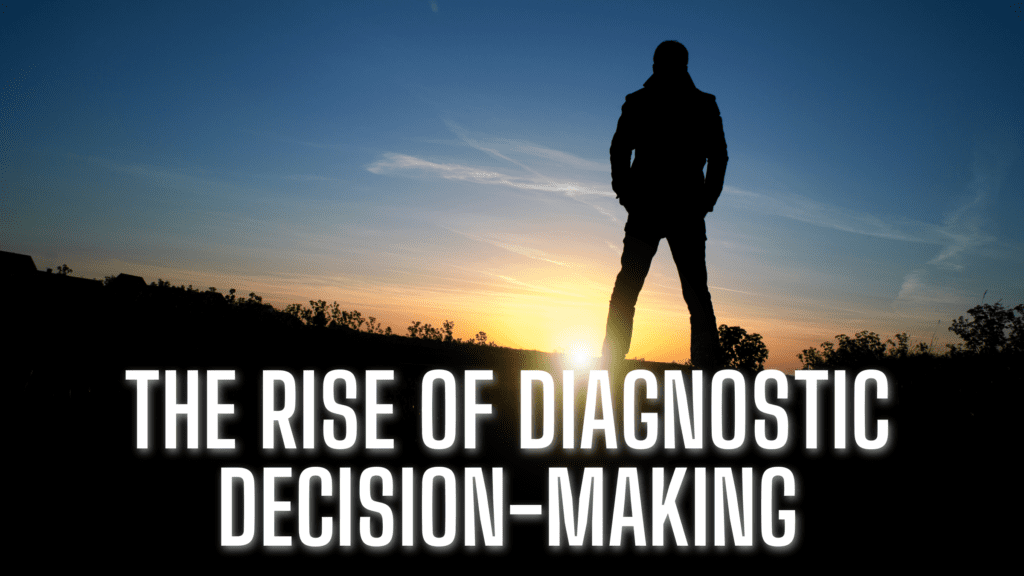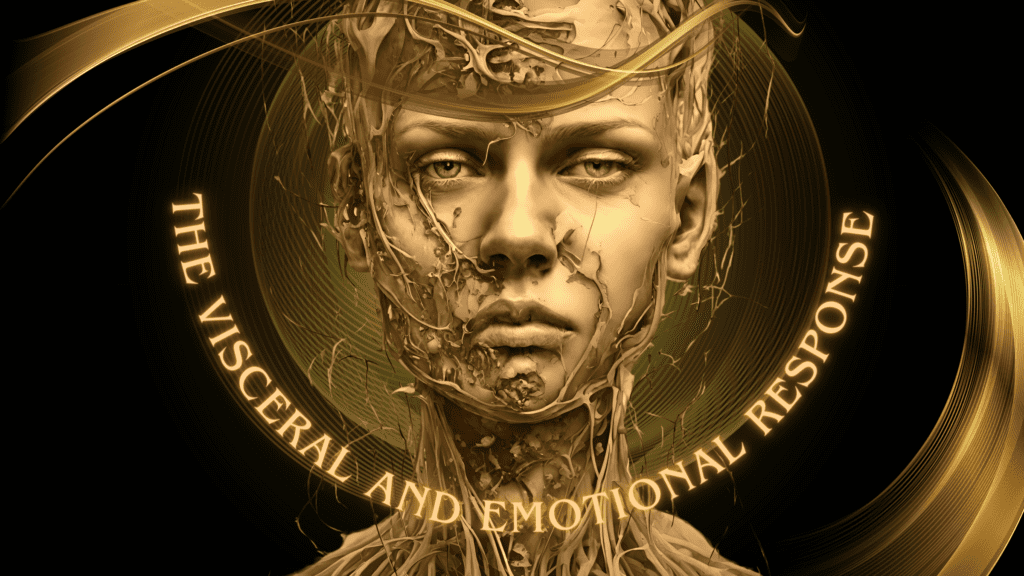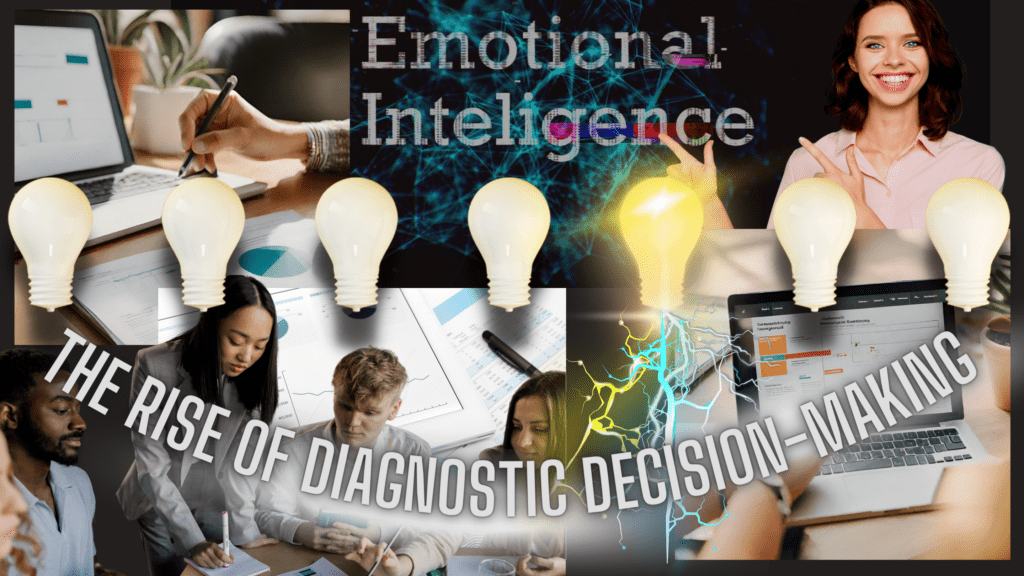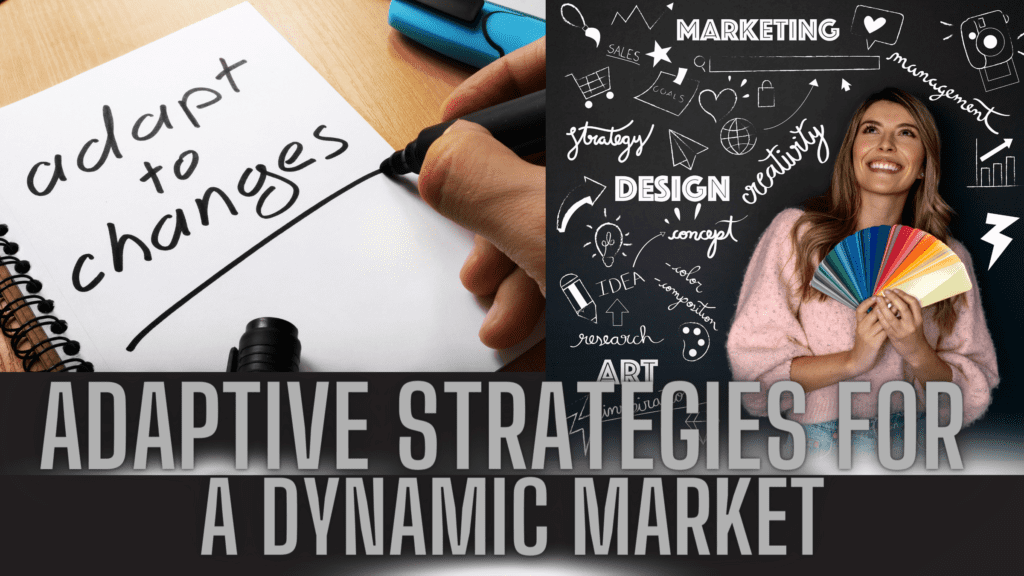
Harnessing Diagnostic Insights for Dynamic Marketing and Communication Strategies

Note to the Reader:
This white paper series embarks on an expedition through the realms of cognitive psychology, the 10,000-hour concept, and the unique role of Marketing Diagnostic Experts. These three pillars intersect to unveil the intricate interplay between science and intuition in advertising, marketing, and communication. This document is divided into three distinct chapters, each shedding light on a fundamental aspect of this journey.
Part I: The Science of Mastery
In this section, we explore the underlying principles of cognitive psychology, which elucidates how human behavior, perception, and cognition shape the success of marketing and communication strategies. We examine how understanding the intricacies of the human mind can guide us in crafting messages that resonate deeply with our audiences.
Part II: The Ten-Thousand-Hour Principle
Deliberate practice, experience, and the commitment to ongoing learning are the hallmarks of the ten-thousand-hour concept. Part II will delve into the journey of achieving mastery in the complex field of marketing and communication, emphasizing that there are no shortcuts to expertise. We will showcase real-world examples of how these principles have shaped the careers of marketing specialists at Multimedia Marketing Group.
Part III: The World of Marketing Diagnostic Experts
The third pillar of this journey introduces us to a world of experts, the Marketing Diagnostic Experts who have honed their skills through decades of practice and understanding. We will uncover their secrets, exploring how their experiences have enabled them to offer invaluable guidance to those seeking excellence in marketing and communication.
In this 3-chapter white paper, we unveil the secrets held at the intersection of Diagnostic Decision Making, revealing a roadmap for those who aspire to excel in the ever-evolving field of marketing and communication. Welcome to a world where expertise is the ultimate currency, and Multimedia Marketing Group is your trusted guide on this transformative journey.
Beyond Intuition
Diagnostic Experts Chapter One
In an age where the digital landscape evolves at an unprecedented pace, marketing and communication professionals face the intricate challenge of not only keeping up with trends but also deciphering the myriad of data generated in real-time. Amidst this complexity, diagnostic decision-making emerges as a linchpin for organizations striving to navigate the dynamic marketplace and secure a competitive advantage.
Diagnostic decision-making serves as a crucial tool for extracting meaning from this data, enabling organizations to make informed decisions that drive competitive advantage. This white paper explores the significance of diagnostic decision-making in today’s marketing and communication landscape, delving into its benefits and outlining practical approaches for implementation.
Diagnostic decision-making refers to the process of assessing and analyzing information to arrive at a conclusion regarding the nature, cause, or classification of a particular situation or condition. This concept is particularly relevant in fields such as medicine, where healthcare professionals use diagnostic decision-making to identify and understand medical conditions in patients. However, the principles of diagnostic decision-making can be applied to various other domains, including business, engineering, and technology, as in our case, marketing, and communication.
Diagnostic decision-making in marketing and communication is also the systematic process of extracting actionable insights from data to inform strategic choices. This white paper delves into the pivotal role of this methodology, emphasizing its significance in transforming traditional approaches into agile, data-driven strategies. As businesses grapple with an ever-expanding pool of information, those adept at diagnostic decision-making gain the ability to not only decipher market nuances but also predict trends and adapt with unparalleled precision.
Applying the Expertise of Diagnostic Blenders in Marketing & Communication
Just like in other fields, marketing and communication professionals can greatly benefit from blending human intuition and data-driven insights. This combination allows them to make better decisions, create more effective campaigns, and achieve their communication goals more effectively.
Human intuition refers to the ability to understand or know something immediately, without the need for conscious reasoning. It is often described as a gut feeling, instinct, or an inner sense that guides decision-making or understanding without relying on explicit, logical analysis. Intuition is thought to be a form of implicit knowledge that arises from a combination of past experiences, patterns, and subconscious processes.
The Role of Human Intuition
While intuition can be a valuable and rapid decision-making tool, it is not always infallible, and its accuracy can vary depending on factors such as expertise in a particular domain, emotional state, and the complexity of the situation. Intuition can be honed and refined through experience and practice, and individuals may develop a heightened sense of intuition in areas where they have significant expertise.
In various fields, including psychology and philosophy, the nature and reliability of intuition have been subjects of study and debate. Some argue that intuition is a crucial aspect of human cognition, while others emphasize the importance of critical thinking and analysis in decision-making.
While data offers valuable guidance, it doesn’t always provide the full picture. This is where human intuition comes into play. Intuition is the ability to understand or know something instinctively, without the need for conscious reasoning. It’s the gut feeling that seasoned marketers develop over years of experience. In the ever-evolving landscape of marketing and communication, gut feelings remain a valuable and intuitive force, helping professionals adapt, innovate, and make impactful choices.
These visceral and emotional responses are associated with gut feelings, emphasizing their significance in decision-making, creativity, and connecting with audiences in marketing and communication. The intuitive marketer can read between the lines, discern subtle shifts in consumer sentiment, and anticipate emerging trends. They can sense when a message is likely to resonate emotionally with an audience, even if the data suggests a different approach. In essence, intuition is the art of tapping into the unspoken desires and emotions of consumers.
Intuition is often closely related to what people commonly refer to as a “gut feeling.” A gut feeling is an intuitive sense or instinctive reaction to a situation or decision without relying on conscious, analytical reasoning. While they are related, there are subtle differences:
- Intuition: Intuition is a broader concept that encompasses various forms of subconscious knowledge and understanding. It can include gut feelings, but it also extends to more complex insights derived from past experiences, pattern recognition, and emotional cues.
- Gut Feeling: A gut feeling is a specific type of intuition that often relates to a quick, instinctive reaction or hunch about a situation. It’s like a visceral or emotional response to something that feels right or wrong without a clear, rational explanation.
In essence, gut feelings are a subset of intuition, and both rely on our innate ability to process information at a subconscious level and arrive at decisions or judgments without explicit analysis. They play a role in various aspects of life, including decision-making in marketing and communication, where rapid, emotionally driven choices can be valuable in creative thinking, audience engagement, and addressing crises.

The Visceral and Emotional Response of Gut Feelings
A gut feeling is a unique aspect of human intuition, characterized by visceral and emotional responses that guide decision-making. In this white paper, we’ll delve into the nature of these responses, their significance, and how they influence choices in various aspects of life, including marketing and communication.
The Visceral and Emotional Nature of Gut Feelings
- Immediate Sensation: Gut feelings are often described as an immediate, almost instinctive sensation. When faced with a decision or situation, there’s a rapid response, often before conscious analysis.
- Physical Reactions: Gut feelings can manifest as physical sensations in the body, such as a “knot” in the stomach, a sense of tension, or a feeling of lightness.
- Emotional Arousal: Gut feelings are closely tied to emotions. They can evoke feelings of excitement, apprehension, trust, or unease, depending on the situation.
- Subconscious Processing: These responses occur at a subconscious level, drawing from a vast reservoir of past experiences and emotional memories.
Significance of Gut Feelings
Gut feelings serve several important functions:
- Rapid Decision-Making: In situations where time is limited, gut feelings allow for quick decision-making. This can be critical in marketing for seizing opportunities or in crisis communication.
- Risk Assessment: Gut feelings often help assess risks. When something feels “off” or unsafe, it prompts caution.
- Creativity and Innovation: In marketing and communication, gut feelings can drive creative thinking and innovation. They inspire unconventional ideas that resonate emotionally with the audience.
- Audience Understanding: Gut feelings can help professionals connect with the emotional responses of their target audience, enabling more resonant messaging and content creation.
- Trust and Credibility: Trust in a gut feeling can lead to decisions that bolster trust and credibility, critical in relationship building and brand reputation.
Challenges and Subjectivity
While gut feelings are valuable, they can also be influenced by personal bias, emotional states, and prior experiences. This subjectivity means that gut feelings should be balanced with data-driven analysis, especially in complex, high-stakes situations.
Cultivating Gut Feelings
Communication Professionals can cultivate and refine their gut feelings through experience, reflection, and continuous learning. Over time, they can develop a better sense of when to trust their instincts and when to complement them with reasoned analysis.
An Emotional Guide
Gut feelings are emotional guides that play a vital role in decision-making in marketing, communication, and various other fields. They provide a rapid, visceral response that complements data-driven analysis and conscious reasoning. Professionals who harness the power of gut feelings are better equipped to navigate complex, emotionally charged situations, make creative decisions, and connect with their audiences on a deeper, more authentic level.
If you’d like to explore specific aspects of gut feelings further or have additional questions on this topic, please feel free to let me know.
The Challenge of Data Overload
The digital age has ushered in an era of information abundance. Marketers and communicators are bombarded with data from diverse sources, including customer behavior, website traffic, social media engagement, and market research. While this wealth of information holds immense potential, harnessing its true value remains a significant challenge. Traditional, gut-driven approaches are often inadequate in the face of such complexity, leading to missed opportunities and suboptimal campaign performance.

The Rise of Diagnostic Decision-Making
Diagnostic decision-making emerges as a powerful solution to this challenge. This systematic approach moves beyond simply analyzing data; it delves deeper to understand the underlying causes of market phenomena and predict future trends with remarkable accuracy.
The development of diagnostic reasoning expertise in marketing and communication is crucial for professionals in this field. While there may not be a concrete method for lifelong education in this area, there are strategies and principles that can help marketers and communication consultants improve their diagnostic skills. One such strategy is the use of the Dual Process Theory (DPT) as a fundamental principle for diagnostic reasoning. Here are some steps to consider when developing a diagnostic strategy in marketing and communication:
1. Understand the Dual Process Theory (DPT)
-
- The DPT highlights the importance of both intuitive and analytical processes in decision-making. In marketing and communication, this means that professionals should balance gut instincts and data-driven analysis.
2. Define Diagnostic Strategy:
-
-
- Develop a clear understanding of what “Diagnostic Strategy” means in the context of marketing and communication. This strategy involves applying diagnostic reasoning principles to daily practice.
-
Defining Diagnostic Decision-Making in Marketing
At its core, diagnostic decision-making in marketing and communication involves a systematic and data-centric approach to understanding, analyzing, and interpreting the plethora of information available. It transcends the traditional decision-making processes by placing a premium on actionable insights derived from comprehensive data analysis. Whether it’s dissecting market trends, evaluating brand perception, or optimizing communication channels, this methodology enables marketers to navigate the complexities of the modern business environment with unparalleled precision.
3. Identify Key Components:
Break down the components of diagnostic reasoning in marketing and communication. This may include market research, data analysis, consumer behavior understanding, and problem-solving skills.
4. Training and Education:
-
-
- Consider formal and informal training and education options for marketing professionals. This could include workshops, courses, seminars, and self-directed learning.
-
5. Guidelines and Principles:
-
- Develop and disseminate guidelines and principles that provide a framework for diagnostic reasoning. These guidelines should cover best practices, ethical considerations, and strategies for addressing complex client situations.

Adaptive Strategies for a Dynamic Market
In the past, marketing strategies were often crafted with a long-term vision, relying on periodic assessments and adjustments. However, the contemporary landscape demands a more adaptive and responsive approach. Diagnostic decision-making empowers marketers to continually monitor, evaluate, and refine strategies based on evolving data. This iterative process ensures that organizations not only keep pace with changes in consumer behavior but also proactively shape their brand narrative in alignment with market trends.
6. Case Studies and Real-Life Scenarios:
-
- Use case studies and real-life scenarios to provide practical experience in diagnostic reasoning. As marketers and communication consultants there is a prevalent need to analyze past campaigns and projects to understand what worked and what didn’t.
7. Feedback and Mentorship:
-
-
- Encourage feedback and mentorship in the industry. Experienced professionals can offer guidance to those looking to improve their diagnostic skills.
-
8. Continuous Learning:
-
- Promote a culture of continuous learning. Marketing and communication strategies evolve, so professionals should stay updated with the latest trends and technologies.
9. Testing and Adaptation:
-
- Test different diagnostic strategies in real-world situations and adapt as needed. The ability to learn from successes and failures is critical in marketing and communication.
10. Data Utilization:
- Emphasize the importance of data in diagnostic reasoning. Professionals should be skilled in collecting, analyzing, and interpreting data to inform their decisions.
Significance of Data-Driven Decision-Making
The sheer volume and velocity of data generated in today’s digital ecosystem necessitates a departure from intuition-based decision-making. Diagnostic decision-making, by contrast, offers a structured framework for harnessing the power of data. This not only provides a deeper understanding of consumer preferences and market dynamics but also facilitates the identification of opportunities and challenges in real-time. In an era where the relevance of marketing messages can wane in an instant, the ability to pivot strategies swiftly based on diagnostic insights is a competitive advantage.
11. Ethical Considerations:
- Ensure that diagnostic reasoning takes into account ethical considerations, especially when making decisions that impact consumers, stakeholders, and society.
Navigating the Contentious Terrain of Consumer Data
While the potential of diagnostic decision-making is vast, it brings forth considerations regarding the ethical use of consumer data. This white paper addresses these concerns, emphasizing the importance of responsible data practices and the need for transparency in the collection and utilization of information. Striking a balance between harnessing the power of data and respecting consumer privacy is pivotal in ensuring the sustainability and ethicality of diagnostic decision-making in marketing and communication.
12. Collaboration and Knowledge Sharing:
- Encourage collaboration and knowledge sharing within the marketing and communication community. Sharing best practices and experiences can enhance diagnostic expertise.
By following these 12 steps and incorporating the Dual Process Theory into the approach, marketing and communication consultants can develop a more structured and effective diagnostic strategy. This will help make better-informed decisions and deliver more valuable services to clients.
These steps also serve as a comprehensive guide to understanding and implementing diagnostic decision-making in your marketing and communication strategies. By leveraging this powerful approach and embracing the transformative potential of data, you can unlock new opportunities, optimize your campaigns, and achieve remarkable results in the dynamic digital age.
For marketing and communication professionals, blending human intuition and data-driven insights can be incredibly valuable in navigating the ever-evolving digital landscape. Here’s how:
Applying the Expertise of Diagnostic Blenders in Marketing & Communication
Just like in other fields, marketing and communication professionals can greatly benefit from blending human intuition and data-driven insights. This combination allows them to make better decisions, create more effective campaigns, and achieve their communication goals more effectively.
Understanding the Audience:
- Human intuition: This helps to understand the audience’s emotions, motivations, and cultural nuances. Intuition can help identify potential trends and preferences that might not be readily apparent in data sets.
- Data-driven insights: Analyzing demographics, website traffic, social media engagement, and customer feedback provides quantifiable data about audience behavior and preferences. This data allows for precise targeting and personalized messaging.
Campaign Optimization:
- Human intuition: This helps to develop creative concepts, craft engaging narratives, and predict how the audience will respond to different messages.
- Data-driven insights: Analyzing campaign performance data helps identify areas for improvement and optimize strategies for better engagement and conversions. A/B testing and data-driven decision-making can lead to significant improvements in campaign effectiveness.
Content Creation:
- Human intuition: This helps to generate creative ideas for content topics, formats, and styles that resonate with the audience. Intuition can also guide the overall tone and voice of the content.
- Data-driven insights: Analyzing website traffic, social media engagement, and search engine optimization (SEO) data helps identify which content formats and topics perform best. This data can be used to inform future content creation strategies.
Building Brand Reputation:
- Human intuition: This helps to understand the brand’s values, mission, and target audience. It allows for the development of authentic and consistent messaging that resonates with the audience.
- Data-driven insights: Analyzing social media sentiment, media coverage, and customer feedback provides valuable insights into how the brand is perceived by the public. This data can be used to identify areas for improvement and protect the brand’s reputation.
Personalization and Targeting:
- Human intuition: This helps to understand individual customer needs and preferences. Intuition can help create personalized messages and experiences that resonate with each individual.
- Data-driven insights: Analyzing customer data, purchase history, and website behavior allows for targeted advertising and marketing campaigns. This data can be used to personalize product recommendations and offer relevant content.
Adapting to Change:
- Human intuition: This helps to anticipate and adapt to changing trends and market conditions. Intuition can help identify emerging opportunities and address potential risks.
- Data-driven insights: Analyzing real-time data and social media trends provides insights into what is happening in the moment. This data can be used to adjust marketing strategies and respond to changing circumstances quickly.
By combining human intuition and data-driven insights, marketing and communication professionals can develop more effective strategies, create more engaging content, and build stronger relationships with their audience. This blend of creativity and data-driven decision-making allows them to thrive in the competitive and dynamic digital landscape.
Categories
Recent Posts
- Maximize Your Reach: Essential Email Marketing Dos and Don’ts for Success July 9, 2024
- Social Media Day 2024 June 30, 2024
- Navigating the World of Social Media Advertising June 20, 2024
- The Power of Visual Content in Marketing April 8, 2024
- Hip Hopper Alert: Easter Bunny Steals the Show with Sunglasses Stunt March 31, 2024
- The Super Bowl Ads 2024 February 12, 2024
- Serving Our Client’s Social Media Platforms Branded Content February 5, 2024
- Days of Future Past January 31, 2024
- The Art of Blending Human Intuition and Data-Driven Insights January 31, 2024
- Beyond Intuition January 30, 2024
Recent Comments